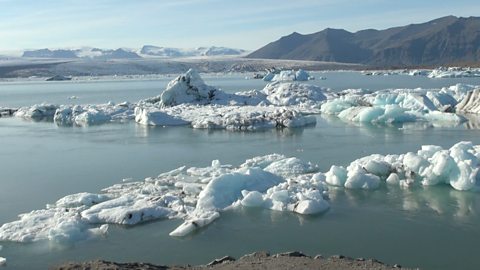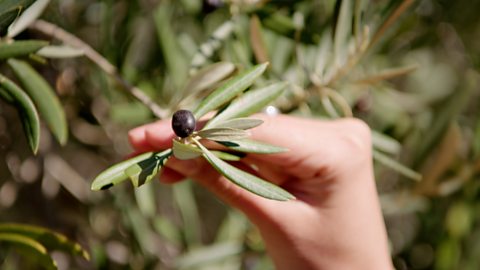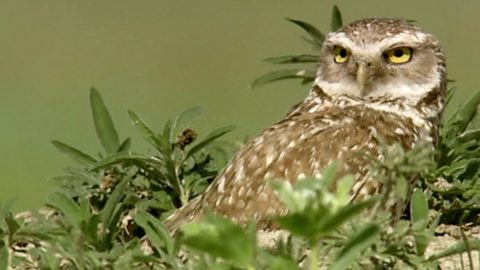Exploring how people, animals and plants have adapted to survive the freezing conditions in the polar biome.
The video
The Antarctic in the southern hemisphere and the Canadian Arctic in the northern hemisphere are part of the polar biome. Whilst these regions might not be your typical travel destination, despite their extreme conditions, they have lots of wildlife.
How have they evolved to survive the freezing conditions?
The polar landscape is extremely hostile: typically rocky and covered in snow and ice. The soils are frozen - this is called permafrost.
You’ll always need to wrap up warm in the polar biome as the average temperature drops to below 10C even during the warmest months.
In Antarctica temperatures can drop down to -50C and below in the winter! Yes -50C! The extreme cold results from the limited amount of sunshine received here.
There’s complete darkness throughout the winter! Polar regions also tend to be very dry, with annual precipitation below 250mm. So, in fact, they’re cold deserts!
So, with these harsh conditions how do plants survive?
In the Arctic only about 5% of the ground surface has plant cover. They cope with the very short growing season by flowering and setting seed very rapidly.
To deal with the strong winds and intense cold they tend to form ‘cushions’ close to the ground.
Along with lichens and ‘cushion’ plants, one plant that survives here is Antarctic grass. It is found in the Antarctic Peninsula area, where conditions are slightly - only slightly - less extreme. It has the ability to photosynthesize at very low temperatures.
This lack of sunlight, combined with frozen soils and reduced vegetation, make it difficult for animals to survive in polar environments, but some - like the polar bear - have evolved to cope. In order to retain heat, they have a thick layer of fur, a 10cm layer of insulating fat, and small ears. Their black nose and foot pads absorb sunshine and help to warm them. You wouldn’t think it would be an issue, but to avoid overheating they move slowly and rest often and their white colour against the snow and ice acts as camouflage when they are hunting. Their wide paws and claws are adapted for swimming, catching prey and digging dens in the snow.
Now there’s no prize for guessing which bird loves the cold, polar regions.
Yep, it’s the penguins.
Found in the southern hemisphere, these feathered friends are well-adapted to the cold, aquatic environments. They have heavy bones allowing them to stay underwater, wings shaped like flippers and watertight feathers. These guys are pretty intelligent and they have learnt that huddling together can keep them warm and protect them from predators.
Despite the polar biome’s conditions, there are many groups of people that live in the Arctic.
The largest group of people in the Canadian Arctic are the Inuit. They live along the coast and hunt seal, caribou and whales.
The Inuit used to be known as Eskimos - which means ‘eaters of raw flesh’.
The Inuit people dress very warmly in the winter because of the cold winds and blizzards. Their traditional clothing is made of caribou hide or sealskin. The Inuit eat traditional foods obtained by hunting and fishing. Some country foods are seal, walrus, whale, musk ox and Arctic hare.
Because of the permafrost, houses can’t be built on the ground as the heat would melt the frozen ground, so all the buildings are on stilts.
Polar regions are becoming increasingly attractive for the exploitation of resources such as fish, oil, coal and other minerals. For example, Svalbard 1000km north of Norway, has highly-valued reserves of coal and its seas are rich in fish, such as cod.
Well, from Antarctic grass to penguins, plants, animals and humans have learnt to survive these icy cold conditions and flourish in this fascinating ecosystem.
Video summary
Download/print a transcript of the video.
Exploring the polar biome and how plants, animals and people have adapted to live in this biome.
Presenter Ferne Corrigan locates the two polar regions and describes the climate in this biome. She describes how Antarctic grass has adapted to survive the freezing conditions in polar regions, and how polar bears have also adapted to live in the Arctic.
The Inuit people of North America survive the harsh conditions by using the environment and animals around them.
Finally Ferne considers how humans are increasingly exploiting the natural resources of the polar regions.
This clip is from the series Ecosystems and Biomes.
Teacher Notes
Key Stage 3
This could be used to introduce students to the polar ecosystem, and how different species have adapted to these extreme conditions.
Students could create fact-files on how plants, animals and people have adapted to thrive in this biome.
Students could look in more detail at the daily lives of the Inuit people and the natural resources that the ecosystems offers.
Key Stage 4
This could be used to refresh students knowledge of the polar ecosystem, and how different species have adapted to these extreme conditions.
Students could create fact-files on how plants, animals and people have adapted to thrive in this biome.
Students could look in more detail at the daily lives of the Inuit people and the natural resources that the ecosystems offers.
This clip will be relevant for teaching Geography at KS3 and GCSE.
This topic appears in OCR, Edexcel, AQA, WJEC KS4/GCSE in England, CCEA GCSE in Northern Ireland, Progression Step 4/5/GCSE in Wales, and SQA National 4/5 in Scotland.
How animals have adapted to live in the Arctic tundra. video
How people, animals and plants have adapted to survive the harsh Arctic tundra biome.

Wildlife adaptations of the Mediterranean biome. video
How people, plants and animals have adapted to the conditions of the Mediterranean biome.

The wildlife and ecosystem of temperate savannas. video
Exploring grasslands to discover how plants, animals and people have adapted to the temperate savanna biome.
